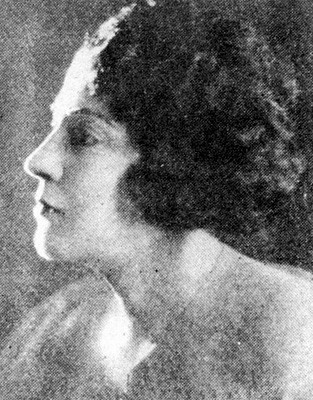


NEWS:
Only 2 days left to hear our September stream - otherwise go to MixCloud to listen but without detailed artist/gig info
Artist Info
|
Marika Papagika  Image from Discogs  Marika Papagika Μαρίκα Παπαγκίκα (September 1, 1890 – August 2, 1943) was a popular Greek singer in the early 20th century and one of the first Greek women singers to be heard on sound recordings. Marika Papagika Μαρίκα Παπαγκίκα (September 1, 1890 – August 2, 1943) was a popular Greek singer in the early 20th century and one of the first Greek women singers to be heard on sound recordings.Marika Papagika was born on the island of Kos near Turkey on September 1, 1890. In late 1913 or early 1914, she recorded for the Gramophone Company in Alexandria, Egypt. Only one of those recordings have so far been found. She emigrated to America through Ellis Island in 1915 with her husband, Kostas (Gus) Papagika, a cymbalom player who was also her accompanist. In July 1918, she made her first trial recording in the States for Victor Records, though her first published Victor recordings were made in December of that year. In July, 1919 she also began recording for Columbia Records. Marika Papagika was thus among the first to record Greek music in the USA.[1] She also recorded a number of songs in Turkish. By 1925, Marika and Kostas had opened a nightclub on in New York on W. 34th St near 8th Ave, called Marika's, likely the first café-aman—a gathering place characterized by Greek cuisine and Greek music—to appear in the States. Marika's wasn't just a café-aman, but a speakeasy for Greek people as well as for other Mediterranean immigrants. Marika's attracted not only Greeks as regular patrons, but also Albanians, Arabs, Armenians, Bulgarians and Turks. Between 1918 and 1929, she recorded at least 232 performances of café-aman styled songs, including kleftiko demotikο (Greek traditional songs about Klephts, heroic brigands), rebetiko, and light classical pieces, many of them overlapping with her chief rival in Greek music sales in the United States, Koula Antonopoulos (known on her recordings as Kyria Koula or "Madame Coula"). Marika's café-aman was a successful business until the stock market crashed. The club closed in 1930, and Marika Papagika's recording career ended, except for four sides recorded for Victor in 1937. In her later years Marika lived with her husband on Staten Island, New York, where she died on August 2, 1943. Marika Papagika distinguished herself from most of her contemporaries by virtue of her sweet soprano voice with its relatively high tessitura, her vocal timbre, somewhat reminiscent of Western classical singers, and her diction. The style and sound of her recordings is further distinguished by the particular accompaniment which graced most of them, namely the unusual combination of cymbalom and violoncello, plus a violin or a clarinet, and, very occasionally, a xylophone. Her occasional forays into more purely Western songs also set her apart from her female contemporaries on both sides of the Atlantic. It is perhaps reasonable to understand the performance styles of Mr. & Mrs Papagika & Co. as a true echo of the "santouro-violi" (santouri and violin) music of late 19th century urban Ottoman and mainland Greece. The major source of information as to Papagika's accompanists is Richard Spottswood's Ethnic Music On Records Vol 3 pp 1197–1204. Papagika was accompanied on all but about 50 of her recordings by her husband Gus and by cellist Markos Sifnios, one of very few cellists in Greek folk music recordings. The upper instrumental part was usually played by one of various violinists, including Athanasios Makedonas, Vangelis Naftis (to whom she calls out on the song "Aïdinikos Horos"), George Theologou, and the Epirot Alexis Zoumbas, or by a clarinettist, most frequently Nicholas Relias (1922-1925), and on one session Pete Mamakos. Some orchestral accompaniments were directed by Nathaniel Shilkret, some by hitherto anonymous directors. After her death, Papagika's music faded into obscurity, and was only available to those with access to her 78 rpm records, often collectors and enthusiasts in the USA and in Greece. From 1976 onwards, with the first crop of LP reissues of Greek music from the earlier decades of the 20th century, her songs were again to be heard. In Greece a total of at least twenty-nine of her songs were reissued on eight LPs between 1976 and 1984 (see discography). In 1984(?) a USA-produced LP featured two Papagika songs. During the analogue reissue era Papagika was thus represented as generously on LP as her colleague Roza Eskenazi, and considerably more than Rita Abadzi and Madame Coula. Since the early 1990s, Papagika's songs have featured regularly in American, French, and Greek-produced CD reissues focusing on the musical genre often called "rebetiko", including the first reissue solely dedicated to her, a 19-track compilation released in 1994 by Alma Criolla Records, USA. In 1995, Marika Papagika was the subject of an episode of NPR’s All Things Considered where Dick Spottswood introduced her music to the North American audience. Τhe first Greek reissue entirely dedicated to Papagika appeared in 1999, and this was expanded to a 3-CD set in 2008, presenting a grand total of 52 songs. A recent USA LP reissue has included seven songs previously not reissued. Read more on Last.fm. User-contributed text is available under the Creative Commons By-SA License; additional terms may apply. Artist biography from last.fm Some other places to look for information: last.fm Discogs MusicBrainz |
